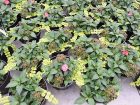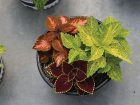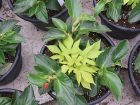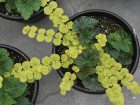
Features
Crops
Flowers
Mixed containers: A grower’s guide to getting it right
If you want to grow the best mixed containers, don’t make them an afterthought.
October 7, 2019 By Melhem Sawaya
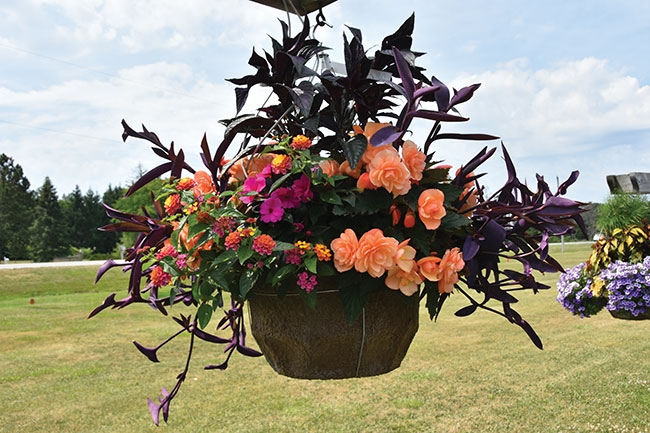 All photos from: M. Sawaya
All photos from: M. SawayaAs a bedding plant grower, you want to grow the item that is most profitable. Unfortunately, demand for that item could be limited. We only can grow items that are in demand and work to make them as profitable as possible.
With the popularity of mixed containers, we need to produce excellent combinations at the most effective cost. The following guidelines are meant to help you achieve that.
To produce a profitable product and ultimately a profitable business, it’s important to understand the product you are trying to achieve and plan every step ahead of time.
Perceived understanding of mixed containers
Leftover liners: Gone are the days when you thought you could put together leftover plants from other plantings. Combinations are planned crops and not an afterthought.
Last-minute trailers: If you are short on availability and you put in a couple of trailing plants as a quick fix, you will end up with a patched-up inferior product that increases your chances of losing your orders for the next season.
Magazine pictures: If you’re taking a picture from a magazine or a breeder’s catalogue and making it the basis for most of your production, the results will not turn out the same way as the picture in many cases.
Plants typically do not survive together long: The combination looks great for one week, then falls apart. Cultivars can clash, and the more vigorous varieties can take over. In those cases, the four- to six-variety combinations end up as two- to four-variety combinations, and those can sometimes become one-variety combinations. First try the magazine picture on a small scale and see how it works for you and the consumer, then expand on the program if performance and profit are both favourable.
Your favourite cultivar: Many combinations have to include a certain cultivar because it is your favourite. Other cultivars are thrown in with it, regardless of whether they’re compatible. Customers have different preferences and we should avoid forcing our personal tastes on them, or else we might end up with larger recycling piles.
A cultivar surplus: Computers are great tools, but adding an extra zero to an order can happen easily and often, so the surplus ends up in every combination. Remember that correcting any mistake at an early stage is the most cost-effective approach. The ultimate goal in dealing with the surplus is to increase sales rather than to hinder it, especially at a time when growing area is at a premium. To deal with the surplus, you could use them in some combinations but only if it enhances them, try to sell the surplus or part of it, and/or spread the surplus over different pot sizes that you are already growing. If none of those options or other solutions meet market demand, then it is much more cost-effective to discard the extras at the propagation stage.
The definition of a mixed container
Every grower should have their own definition of a mixed container (combination). It is similar to a mission statement for your operation, which sets the basic standards or principles for your combinations.
The definition that I would use for my combinations is: a group of two to four cultivars (varieties) that would grow and look better together in combination than they would separately, while generating higher profit margins.
There are several different ways of approaching mixed containers:
- Two to four cultivars of the same genus, such as three petunias or three calibrachoa of different colours that have the same growing habit.
- Two to four genera per container, such as a combination of petunia, calibrachoa and verbena, or a combination of lobelia, pansy and bacopa. Just make sure you are selecting genera that grow under similar cultural conditions.
- Colour-coordinated varieties that are becoming very popular, because they are intended to match certain window shutters, doors and or patio furniture. Make sure the combination meets the standards you set.
- Leaf size and texture coordination, so that one variety doesn’t take over the whole container.
- Monochrome of different cultivars to match lawn furniture, occasions like weddings, buildings, restaurants or any other business.
Production
Media: Whether it is a combination or any other crop, potting media should be tested by an independent testing laboratory before use. This is mainly done to find out if the pH of the media is where you want it to be. My preference is to have a pH between 5.5 and 5.8, since 90 per cent of the main cultivars in combinations are petunia and calibrachoa. This pH is not the best for geraniums, but on the other hand, geraniums don’t belong in any combination. By July, the geranium tends to be totally dwarfed by the rest of the cultivars. Soil EC should be between 0.6 and 0.7, tested using 2 parts water to 1 part media, by volume.
Water: Water liners or 4” pots with fertilizer of 1.5 to 2.0 EC before planting. Be sure to water the media before planting to avoid overwatering afterwards. This will help prevent plants from being buried. Water lightly after planting until plants are well-established.
Fertilizer: Using your fertilizer, adjust your pH to 5.6-5.8 and your EC to 1, testing with 2 parts water to 1 part media. To change the pH of your media, use the following:
- Acidic: 18-9-18
- Alkaline: 14-0-14
- Neutral: 17-5-17
Knowing your crops and what they prefer makes the difference between an ‘ok’ crop and an excellent one. Only by testing the soil will you be able to catch fertility variances before it becomes a problem.
Light: Whether it is a combination or one straight variety in a pot, light is very important. Leave room around the containers so that all of the plants in the container are exposed to light, especially when there are plants trailing down the sides. Containers can start pot-to-pot and then be spaced out to finish.
Temperature: Any crop should be started at warmer temperatures of 18-20°C, then finished cool. Some crops can only go down to 5-6°C, while others shouldn’t go below 13°C. When planning your combinations, pick cultivars that are temperature compatible. The worst scenario would be to grow a cool-loving variety that trails warm – the petunia, for example. Some crops cannot take cool temperatures, such as ipomoea or hibiscus (annual and perennial).
Pest control: During spring production, many cultivars tend to be growing at once, which makes pest control an interesting task. Many steps need to be taken, including:
- Starting with clean plant material
- Knowing potential pests that a crop can attract
- If biologicals are used, treat preventatively
- If chemicals are used, monitor very closely and treat accordingly
- Many times, a crop has to be cleaned chemically before biologicals are introduced. In this case, knowledge of your chemicals is important so you can use ones that are safe-to-moderately safe for the biological that you are planning to use.
- Most of the time, both chemical and biological pest control need to be used in a way that complements one another.
- Try to have your pest treatments applied before flowering time, or at least three weeks before shipping, because flowers are generally more sensitive to chemicals than foliage.
Liners: All planted varieties should have been rooted in the same media. Programmed liners or 4” pots are ideal, while Elle guard liners are the preferred choice. In addition, liners should be active, alive, and not yellow. They should not be doped with PGRs, not crowded, not just pinched and finished in full light.
Costing
Profitable greenhouse operations know the cost of every product they produce, that is, if they sell it at a profitable margin. The costing process should be divided into four main categories: direct, indirect, shipping and shrinkage.
Direct costs: They include the following inputs
Pot or container and including all its parts, such as the hanger and saucer
Growing media per pot means taking the cost of whichever media size you bought and actually filling the container you are trying to cost until the whole unit is used. Divide the cost of the media unit (whether it is a tower, half a tower or a 4, 6 cubic foot unit) by the number of containers filled.If you are mixing your own media, you must calculate the cost per cubic foot or cubic metre and know how many containers a cubic foot or cubic metre will fill. Many growers make the mistake of guessing on this calculation, because they figure that the cost per container is small. But when you multiply this cost by the total number of containers grown, then it is no longer a small cost. When calculating the cost per unit, use four digits after the decimal. For example, if your cost for 8” pots is $100 per 60 pots, then the cost per pot should be $1.6667.
Plant material whether it is a liner, a plug or a 4” pot, the cost of any of these units should be included in total plant material costs.
Product enhancement. This could be supporting rings, stakes, care tags, UPC labels, or clips, and let us not forget the ‘Grown in Canada’ sticker.
Growing area should be calculated in sq. ft. each week, which is the amount of space that each container occupies in sq. ft. for however many weeks. Total growing area is a sum of three different stages: pot-to-pot for so many weeks, then at half space for another few weeks, and then final spacing for so many weeks.
Crop maintenance: Fertilizer use could be figured out in different ways. If it is a mono crop, then it is easy to take the cost of the total fertilizer used and divide it by the number of containers. If fertilizer is wasted on the ground it is still a cost. If it is multi-crop, take the total cost and factor in the different fertilizing frequencies before you divide by the total number of pots for every crop.Include water usage costs, even if it is minimal.
Pest control is becoming a bigger cost than it used to be, ranging from one per cent to 10 per cent of the total cost. This includes insecticides, fungicides, and biocontrol.
Labour costs for crop maintenance should include wages for watering, spraying, crop monitoring, pinching, spacing and every step that is involved to keep the crop in its best form. The calculation should include every step taken in seconds and not minutes. When you multiply by the total number of transactions, fractions of a second make a big difference.
Indirect costs
They exist independent of crop size and for the most part, they exist whether a crop is produced or not. Indirect costs can include bank charges (the mortgage, operating loan, principle and interest), and management fees, which cover wages for the owners, accountant, consultant, sales staff, and others not directly related to production volume, and of course, different government fees.
Shipping costs: They used to be three to five per cent years ago, but now shipping cost is somewhere between 15 to 25 per cent due to fuel costs doubling in the last 20 years, wage increases, frequency of delivery (smaller orders are delivered more often), truck insurance (whether you own the truck or you lease it), and depreciation.
Shrinkage costs: This should be factored into every crop cost for two main reasons: 1) to have the right amount promised to your customer and 2) to project your actual costs.
Shrinkage costs could be due to inferior crop quality, crop failure, being sold at a much later date than the targeted date which incurs an extra cost, or not being sold at all. The item could also be sold, but not paid for due to pay-by-scan, complaints (more likely to be excuses because sales at the store are slow) or a bad account (the customer did not pay for the product for other reasons).
All these calculations could be put into an Excel spreadsheet and adjustments can be done quickly and easily. You can also make more accurate decisions based on facts and scenarios on paper before they are put into action.
Guidelines for profitable mixed containers
Here is a checklist for items other than the ones mentioned before.
Plant live, pest-free plants. As obvious as it can be, we still make the same mistake: plant an inferior product and try to make something out of it. Most of the time we can, but at what cost? It’s much better to solve the problem at the beginning because an inferior starting product not only costs more, but it creates situations involving extra treatments to the entire crop – the good ones in addition to the bad ones.
Use the minimum number of liners per container that will achieve a good product at the shippable date. This will result in :
- A more cost-effective plant, as well as a higher quality combination for the consumer.
- The fewer plants in a combination, the greater the water-holding capacity of the media.
- Fewer growth regulators are used, which translates into lower costs and higher quality product.
Because of the extra space in each container, the good vigorous varieties will have a chance to show off their potential. I noticed in our trials that the same vigorous varieties performed much better where no growth regulators were used. After all, we are growing product for the end consumer who expects lush, vigorous gardens and not plants that have gone through a chemical compactor.
Compatible varieties are very important; not just for ease of production but for economics. A very vigorous plant can take over the whole combination, so treat accordingly to fit the rest of the varieties in the combination. On the other hand a very compact variety might and most probably will disappear totally, so varieties like this should not be mixed with vigorous ones.
Fertilizer is as important as any of the other factors mentioned. Fertilize continuously, do not over water and check EC and pH of the media. EC should be close to 1 using the 1:2 media:water test by volume. This should be done on a biweekly basis, which is the cheapest way of ensuring healthy plants and avoiding root damage.
Use high calcium and potassium EC’s to control height. This will make water less available to the plants.
Use different fertilizers to adjust minor soil pH:
- 18-9-18 to lower pH:
- 14-0-14 to raise pH:
- 17-5-17 for neutral pH.
Immaterial of which fertilizer you are using, if the EC is too high the pH will be low. Balance and moderation are key.
Start warm and finish cool. All crops should start warm and finish cool. All plants should have good root systems before they are cooled, but at the same time, it is just as important to cool the crops at the end of the growing cycle – especially cold crops.
Maximum light is a must to grow strong plants that will be acclimatized for outdoor production. We cannot grow plants under three deep rows of hanging baskets and expect them to perform well when they get outdoors in full sun.
Number of cultivars in general is three per combination. More is not better, and it is more difficult to find cultivars that look good and grow well together.
Seed varieties are just as good as vegetative varieties and sometimes they are better. You can also use some of each.
Use the best cultivars, vegetative or seed, because at the end of the day they are the cheapest. ‘Best’ is defined according to your conditions and the outdoor environment of your market.
Treat vigorous varieties with growth regulators before planting. It is the most economical way and the best option for the consumer because this will open a larger window between treatment and selling date. We have to be extremely cautious about when we apply growth regulators before the selling date.
Expensive containers should be used for upscale plantings to justify the cost of the container where the product is not meant to be transplanted. Many presentable containers that function very well are priced reasonably.
Space your planting dates. You do not sell all of your containers in one week so why plant all of them in the same week?
Sell fresh plantings and not old ones for two reasons. Fresh plantings require less maintenance and shorter growing times, which translates into better profit margins. Fresh plantings also have better shelf life at retail and with the end consumer. Because the container media is not rootbound, the planting media will hold more water. Younger plants adjust to different climates more successfully than rootbound containers.
Number of cuttings per pot. 10” baskets are not suitable for combinations. The size is too small and the shelf life is too short. The smallest size should be 12” containers.
- 10”: Not a size for mixed containers
- 12”: 4-5 cuttings
- 14”: 4-5 cuttings
- 16”: 5-7 cuttings
- 20”: 5-7 cuttings
Any more cuttings than that per container can have a negative effect on quality and shelf-life, leading to wasted profit.
Grow only what is ordered. Selling price should clear a minimum profit margin of 20 per cent if any operation is to survive. That is why it is much more important to calculate profit margins than dollar sales.
By calculating your costs before production starts, you will know the parameters of every cost aspect so you do not have surprises at year’s end. It will also give you guidelines to help beat your projected costs when possible.
As mentioned at the beginning of this article, remember that planning is the key to success.
Melhem Sawaya of Focus Greenhouse Management is a consultant and research coordinator to the horticultural industry. Contact him at mel@focusgreenhousemanagement.com.
Print this page

